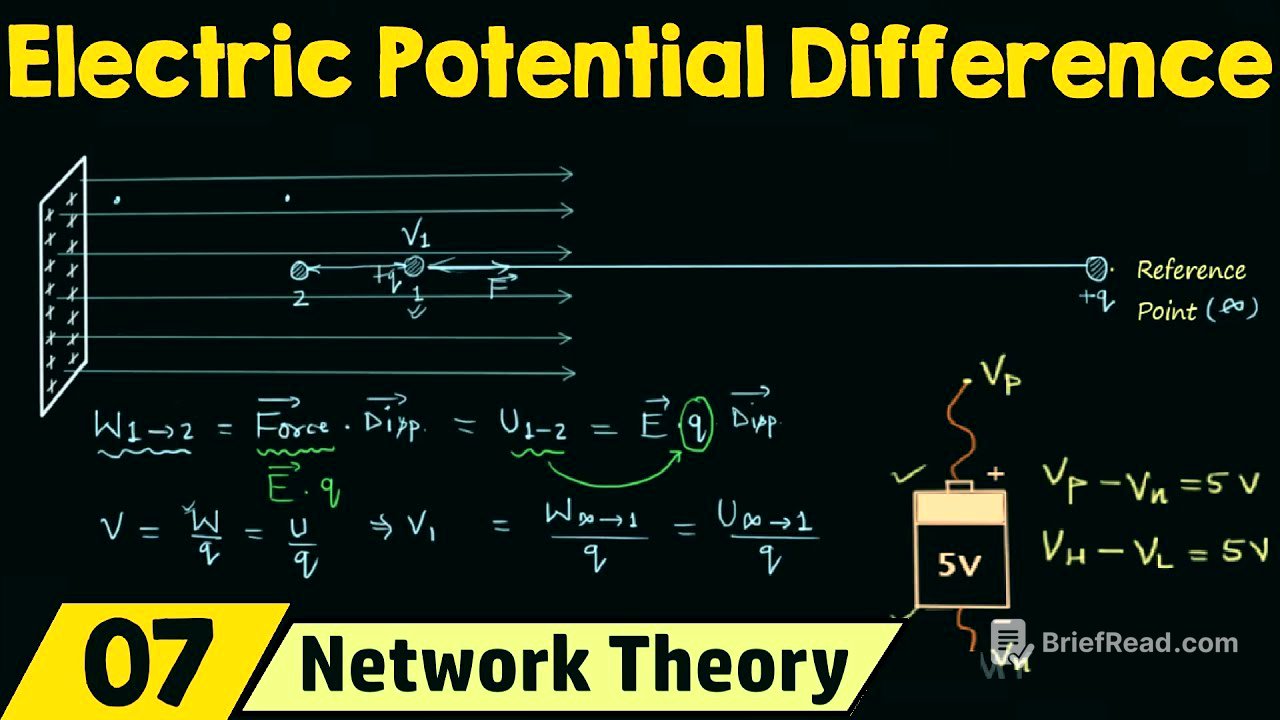TLDR;
This lecture defines electric potential, electric potential energy, and electric potential difference (voltage). It explains how electric potential difference relates to the work done in moving a charge between two points in an electric field and how it is independent of the charge being moved, depending only on position. The lecture also covers batteries as voltage sources, their representation in circuits, and the effect of a negative sign on polarity.
- Electric potential difference (voltage) is the difference in electric potential between two points.
- Electric potential is the work done per unit charge in moving a charge from a reference point to a specific point in an electric field.
- Electric potential energy depends on the charge being moved, while electric potential depends only on position.
- Batteries are voltage sources that maintain a potential difference between their terminals.
Introduction to Electric Potential and Potential Difference [0:00]
The lecture begins by defining electric potential difference, also known as voltage, as the difference in electric potential between two points. To understand electric potential difference, one must first understand electric potential. The explanation uses an arrangement with a positively charged conducting plate, which creates an electric field that can be visualized using electric lines of force. Electric field at a point can be defined using electric field strength (a vector) or electric potential (a scalar). A reference point, usually at infinity, is considered where the electric field's influence is zero.
Electric Potential Energy and Electric Potential Defined [2:59]
A positive test charge is taken from the reference point and moved towards the positively charged plate without acceleration. As the charge moves closer to the plate, it experiences a repulsive electric force. Work must be done to overcome this force, and this work is stored as electric potential energy. The work done in moving the charge from one position to another is equal to the dot product of the force and the displacement, and this work is stored as electric potential energy (U). Electric potential energy depends on the charge being moved in the electric field. Electric potential, on the other hand, is the work done per unit charge in moving a charge from the reference point to a specific point in the electric field, and it is also equal to the electric potential energy per unit charge.
Understanding Electric Potential with an Example [6:46]
A test charge (+Q) is moved from the reference point to position 1, where the potential is V1. The potential at the reference point (infinity or Earth) is zero volts. According to the definition of electric potential, V1 is equal to the work done in moving +Q from the reference point to position 1, divided by the charge Q. This can also be expressed in terms of electric potential energy as (U1 - U∞) / Q, where U1 is the electric potential energy at position 1 and U∞ is the electric potential energy at the reference point. The calculation effectively finds V1 minus the electric potential at the reference point (zero volts), which is the potential difference.
Electric Potential as a Function of Position [9:17]
Whenever the potential at a point is given in an electric field, it is calculated with respect to the reference point. The potential difference (V2 - V1) is equal to the electric potential energy stored while moving the charge from position 1 to 2, divided by the charge itself. This potential difference is independent of the charge being moved and depends only on the positions. Each point in the electric field has a potential that does not depend on the charge placed at that position, but the electric potential energy does depend on the charge.
Shifting the Reference Point and Units of Electric Potential [11:29]
If the reference point is shifted, the potential difference will not change. The SI unit for electric potential energy is Joule. Electric potential is equal to electric potential energy divided by charge, so its unit is Joule per Coulomb, also known as Volts, named after Alessandro Volta. The unit for electric potential difference is the same as electric potential.
Batteries as Voltage Sources [13:17]
A battery is a voltage source because there is a potential difference between its positive and negative terminals. For example, a 5-volt battery has a potential difference of 5 volts between its positive and negative terminals (VP - VN = 5 volts). The positive terminal is at a higher potential than the negative terminal. Batteries can be represented in circuits using symbols, with the longer line indicating the positive terminal and the shorter line indicating the negative terminal. Another common symbol for a DC voltage source is a circle with positive and negative signs.
Calculating Potential Difference in a Circuit [15:41]
To find the potential difference in a circuit, start from one point (e.g., V1), move further, and note the potential difference encountered (e.g., 5 volts). The sign between V1 and 5 depends on the next to next terminal (negative terminal), so the equation becomes V1 - 5 = V2, which can be rearranged to V1 - V2 = 5 volts. Alternatively, starting from V2, the equation becomes V2 + 5 = V1, which also rearranges to V1 - V2 = 5 volts.
Effect of Negative Sign on Polarity [18:23]
Placing a negative sign in front of the potential difference reverses the polarity. For example, if the potential difference is -5 volts instead of 5 volts, the polarity of the voltage source reverses. The lecture concludes by noting that circuit diagrams often use tense lines to represent connecting wires.









